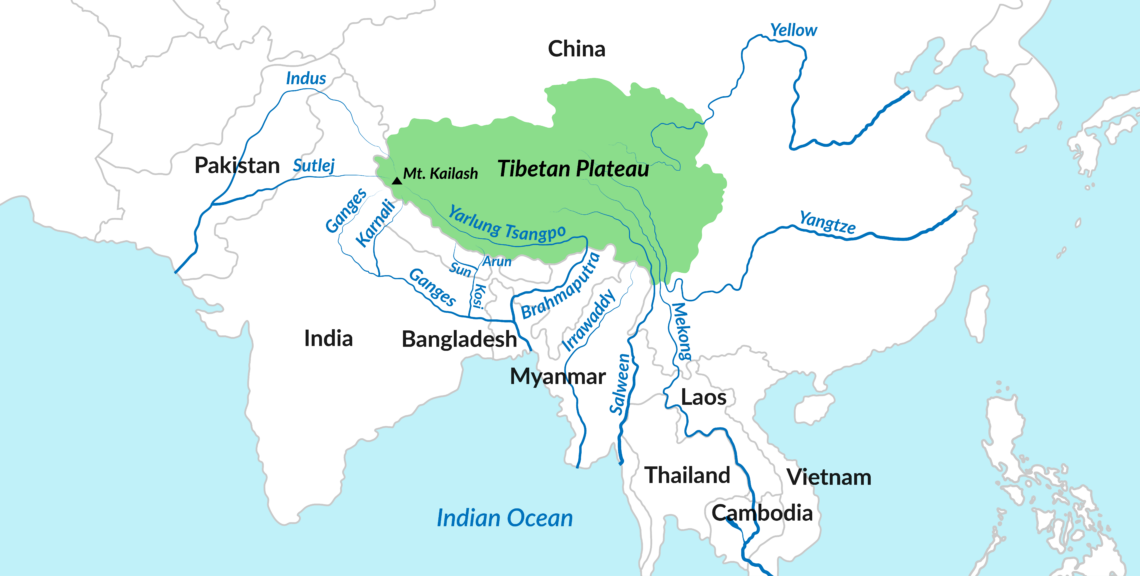Regional hegemony and control of the Tibetan plateau
The recent skirmishes along the Indo-Chinese borders are part of a larger regional conflict. Since China aims to acquire hegemony over many geostrategic points in the Himalayas – including access to several major waterways – military escalation is fated.

The frozen conflict on the long Indo-Chinese border across the Himalayas includes large disputed territories, which are essential if China is to be a hegemony. China claims the Indian State of Arunachal Pradesh, a territory the size of Austria with some 1.4 million inhabitants in the Eastern Himalayas. The smaller Doklam Plateau, a short stretch of the border between China and Bhutan, is also at stake.
On the western side, China occupies parts of Kashmir, 30,000 square kilometers of Ladakh highlands. Inhabited by a few nomads only, the area is situated 3,500 meters above sea level and is mostly covered by salt lakes. However, the region is of great geostrategic importance. Armed clashes, some leading to casualties, occur regularly.
Gateway to India
A few weeks ago, at the Shanghai Cooperation Organisation Summit in Moscow, Russian President Vladimir Putin hosted a debate between Chinese President Xi Jinping and India’s Prime Minister Narendra Modi. The two heads of state discussed the latest skirmish in Ladakh, which cost the lives of several Chinese soldiers. Their exchange was polite enough – but this was largely a show of courtesy toward the host, not an emerging solution to the conflict.
Both sides now have a military presence at the border, and both are attempting to influence the internal affairs of the two buffer Himalayan states, Nepal and Bhutan. India has traditionally been the dominating influence in Nepal, but there is a growing feeling that New Delhi has misused its position. This could allow China to strengthen its position to the south of the Himalayan mountain range, a gateway to the Indian heartland.
The contention concerns more than just control over desolate areas.
The contention concerns more than just control over desolate areas. It is part of a larger regional power struggle and China’s western access to the Indian Ocean through Pakistan. The issue is extremely challenging for both China and India and their respective strategies remain somewhat unclear.
India has always had to contend with threats from the north through the Himalayan mountain range, but historically these came from Central Asia rather than China. The British Empire clashed with the Imperial Court in Beijing over that very border. In 1962, war erupted between India and China and regular altercations have been taking place since. New Delhi views – with good reason – the close collaboration between Beijing and Islamabad as a threat, since it facilitates China’s growing naval presence in the Indian Ocean. In response, India has been expanding its alliances. It has tightened its cooperation with the United States, Australia and Japan. Its military buildup has been significant, but not as large as China’s.
Weighty waterways
In the past, China did not place much importance on its relationship with India. Things changed after the annexation of Tibet in the 1950s, as it sits north of the Indian border. The population of Tibet is still resisting assimilation into the Chinese system. Beijing is ramping up its efforts to break down opposition – in a fashion similar to that being used in northwestern China to make the Uighurs conform to the Communist Party of China’s ideology.
An aspiring Asian hegemony, thus also in the Himalayas, China is increasingly advocating multilateralism, apparently seeking to move into the perceived vacuum left by the U.S. This trend is seen at the UN level and in its agencies. On the other hand, Beijing does not hesitate to bend and violate international norms to advance its national interests. The country’s strategy is contradictory. On one hand, it tries to be a high-level player in global governance efforts. On the other, it fragments and undermines international frameworks by blatantly violating human rights at home and breaking the rules of international trade – not to mention the military and political disruption in Hong Kong, Taiwan and the South and East China Seas.
The Tibetan plateau is crucial in the current confrontation between China and India.
The Tibetan plateau is crucial in the current confrontation between China and India. The main rivers of East and South Asia originate there. Water means life. The Indus, one of Asia’s longest rivers, flows through western Tibet, India (Ladakh) and Pakistan. It is the latter’s primary source of water. The Brahmaputra, important inlets to the Ganges, the Irrawaddy and the Mekong also have their sources on the plateau, as do most important rivers in China. Access to these waterways is essential for Chinese national security and interests. Control of Tibet is the key to regional hegemony.
We can expect Beijing to be increasingly forceful in its bid for domination on the Himalayan border with India. This means that tensions between the two countries are bound to climb.
